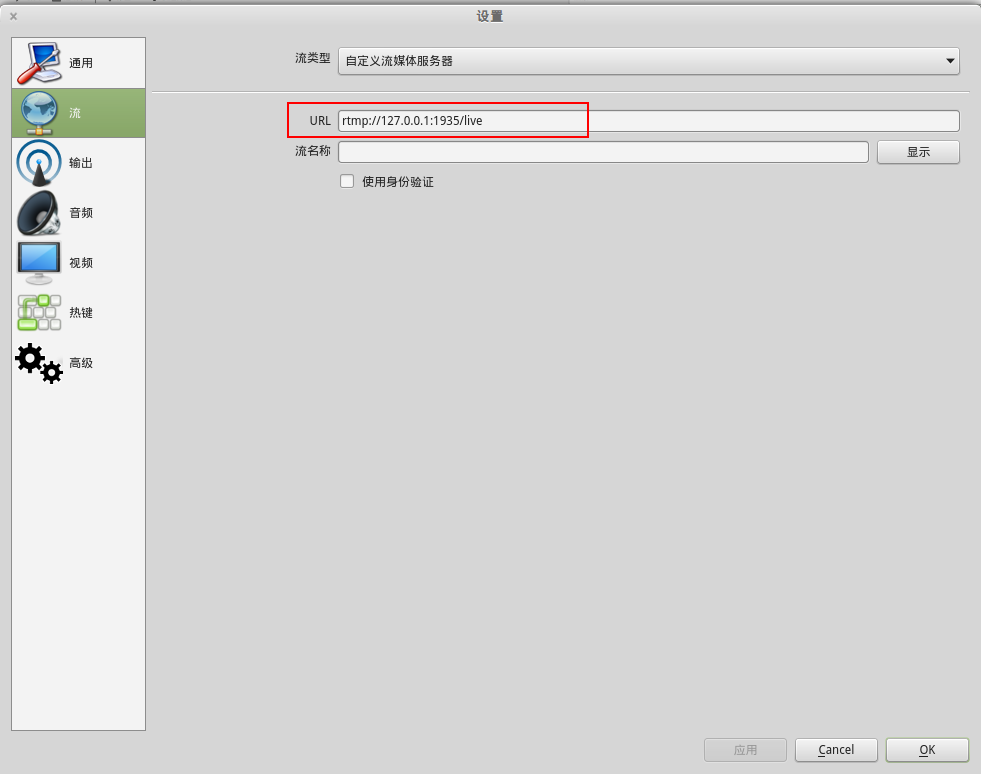 Operation and Maintenance
Operation and Maintenance Linux Operation and Maintenance
Linux Operation and Maintenance Use nginx and nginx-rtmp-module to build a streaming media server
Use nginx and nginx-rtmp-module to build a streaming media serverI encountered a very embarrassing problem when using nginx and nginx-rtmp-module to build a streaming media server. That was the approach I initially took when adding the nginx-rtmp-module module to nginx. First uninstall the original nginx, then download the source code of nginx and nginx-rtmp-module, recompile and install it. After reinstalling, I tested the streaming media server and it was normal, but then the problem came because I had some WEB The projects were deployed in the LUMP environment that was built before. Now that nginx has been reinstalled, these projects need to be redeployed. So, I started to redeploy these WEB projects, but the result made me cry in the toilet because the directory of nginx The structure has changed a lot, so I can't configure the original WEB project. After that, I struggled and wandered for a long time. I searched for many solutions on the Internet, but most of these solutions focused on how to compile and install nginx and The push-pull flow test did not involve my problem. Later, when I was browsing the post, I saw someone saying that replacing the original nginx shared library with the nginx executable file compiled by myself could solve the problem, so I immediately tried it. It turned out that it really works! Now nginx can run streaming media services and deploy WEB projects at the same time, and have the best of both worlds!
Let me briefly introduce my operation process, hoping to help others who encounter the same problem. If you have a problem, please bring some help (my configuration environment: Ubuntu Server 16.04 + nginx1.10.0 + nginx-rtmp-module-master).
1. First install nginx using apt-get. Currently using The version number of nginx installed in this way is 1.10.0
1 sudo apt-get update2 sudo apt-get install nginx
2. Go to your favorite directory and create a directory with your favorite name to store nginx and nginx-rtmp -Module source code, for example: I created the nginx directory under the root directory/softwares (softwares was also created by myself), and then I will download nginx and nginx-rtmp-module to the nginx directory.
1 cd softwares/2 sudo mkdir nginx
3. Enter the nginx directory.
1 cd nginx/
4. Download the nginx source code. Note: The downloaded source code version needs to be consistent with the version of nginx installed in step 1. , to avoid unnecessary problems. There are many ways to obtain nginx source code. Here are two methods recommended.
Method a: Execute apt-get source nginx command in the terminal to directly obtain the source code of the corresponding version.
1 sudo apt-get source nginx
This method will automatically decompress after downloading. The nginx-1.10.0 directory is the nginx source code directory.
Method b: Find the corresponding version on the official website of nginx and then Download.
1 sudo wget nginx.org/download/nginx-1.10.0.tar.gz
After downloading in this way, you need to manually decompress it yourself. Decoding command:
1 sudo tar zxvf nginx-1.10.0.tar.gz
5. Download nginx-rtmp-module Source code.
1 sudo wget github.com/arut/nginx-rtmp-module/archive/master.zip
Because nginx-rtmp-module is open source on GitHub, you can also get it directly from GitHub. GitHub address:
6. Unzip nginx- Compressed package of rtmp-module source code.
1 sudo unzip master.zip
7. Enter the nginx source code directory.
1 cd nginx-1.10.0/
8. View the current nginx configuration information, And save the current configuration information completely to one place. Later, when compiling the nginx source code, you need to configure it based on the current configuration information.
1 nginx -V
Note that the V in the command line is capitalized. , only the version number of nginx can be seen in lowercase. My current nginx configuration information is as follows:
--with-cc-opt='-g -O2 -fPIE -fstack-protector-strong -Wformat -Werror=format-security -Wdate-time -D_FORTIFY_SOURCE=2' --with-ld-opt='-Wl,-Bsymbolic-functions -fPIE -pie -Wl,-z,relro -Wl,-z,now' --prefix=/usr/share/nginx --conf-path=/etc/nginx/nginx.conf --http-log-path=/var/log/nginx/access.log --error-log-path=/var/log/nginx/error.log --lock-path=/var/lock/nginx.lock --pid-path=/run/nginx.pid --http-client-body-temp-path=/var/lib/nginx/body --http-fastcgi-temp-path=/var/lib/nginx/fastcgi --http-proxy-temp-path=/var/lib/nginx/proxy --http-scgi-temp-path=/var/lib/nginx/scgi --http-uwsgi-temp-path=/var/lib/nginx/uwsgi --with-debug --with-pcre-jit --with-ipv6 --with-http_ssl_module --with-http_stub_status_module --with-http_realip_module --with-http_auth_request_module --with-http_addition_module --with-http_dav_module --with-http_geoip_module --with-http_gunzip_module --with-http_gzip_static_module --with-http_image_filter_module --with-http_v2_module --with-http_sub_module --with-http_xslt_module --with-stream --with-stream_ssl_module --with-mail --with-mail_ssl_module --with-threads
9. Configure nginx source code compilation information and add nginx-rtmp-module to nginx .
1 sudo ./configure --prefix=/usr/share/nginx --conf-path=/etc/nginx/nginx.conf --http-log-path=/var/log/nginx/access.log --error-log-path=/var/log/nginx/error.log --lock-path=/var/lock/nginx.lock --pid-path=/run/nginx.pid --http-client-body-temp-path=/var/lib/nginx/body --http-fastcgi-temp-path=/var/lib/nginx/fastcgi --http-proxy-temp-path=/var/lib/nginx/proxy --http-scgi-temp-path=/var/lib/nginx/scgi --http-uwsgi-temp-path=/var/lib/nginx/uwsgi --with-debug --with-pcre-jit --with-ipv6 --with-http_ssl_module --with-http_stub_status_module --with-http_realip_module --with-http_auth_request_module --with-http_addition_module --with-http_dav_module --with-http_geoip_module --with-http_gunzip_module --with-http_gzip_static_module --with-http_v2_module --with-http_sub_module --with-http_xslt_module --with-stream --with-stream_ssl_module --with-mail --with-mail_ssl_module --with-threads --add-module=../nginx-rtmp-module-master
Note that this line of command actually consists of: sudo ./configure
10. After the configuration is completed, execute the make command to start compiling the nginx source code. After the compilation is completed, the nginx executable file will be generated in the objs directory of the nginx source code directory.
1 sudo make
11. Will the generated nginx Copy the executable file to the /usr/sbin directory and replace the original nginx shared library file. Note: There is an nginx shared library file in the /usr/sbin directory. We use the compiled nginx executable file to replace it.
1 sudo nginx /usr/sbin
12. Restart nginx.
1 sudo service nginx restart
13. Check the nginx configuration information again.
1 nginx -V
You can see that the nginx-rtmp-module module has been added to nginx.
1 --prefix=/usr/share/nginx --conf-path=/etc/nginx/nginx.conf --http-log-path=/var/log/nginx/access.log --error-log-path=/var/log/nginx/error.log --lock-path=/var/lock/nginx.lock --pid-path=/run/nginx.pid --http-client-body-temp-path=/var/lib/nginx/body --http-fastcgi-temp-path=/var/lib/nginx/fastcgi --http-proxy-temp-path=/var/lib/nginx/proxy --http-scgi-temp-path=/var/lib/nginx/scgi --http-uwsgi-temp-path=/var/lib/nginx/uwsgi --with-debug --with-pcre-jit --with-ipv6 --with-http_ssl_module --with-http_stub_status_module --with-http_realip_module --with-http_auth_request_module --with-http_addition_module --with-http_dav_module --with-http_geoip_module --with-http_gunzip_module --with-http_gzip_static_module --with-http_v2_module --with-http_sub_module --with-http_xslt_module --with-stream --with-stream_ssl_module --with-mail --with-mail_ssl_module --with-threads --add-module=../nginx-rtmp-module-master
I tried pushing and pulling the stream, and the function was normal. I ran the original WEB project again, and it was normal!
Finally, I will explain why we need to install nginx through apt-get first, and then Compile and replace. The reason is to facilitate the deployment of WEB projects in the LUMP environment. If you do not install nginx through apt-get first, but directly download the source code to compile and install, the nginx configuration directory will be incomplete and it will be difficult to deploy WEB Project (deployment may also be achieved through certain operations, but you still need to spend time studying nginx for the specific operation). If you do not build a streaming media service, I recommend installing nginx through apt-get. The steps are simple and worry-free. !
The above is the detailed content of Use nginx and nginx-rtmp-module to build a streaming media server. For more information, please follow other related articles on the PHP Chinese website!
 如何在 Ubuntu 和其他 Linux 下安装 IDLE Python IDEApr 08, 2023 pm 10:21 PM
如何在 Ubuntu 和其他 Linux 下安装 IDLE Python IDEApr 08, 2023 pm 10:21 PMIDLE(集成开发学习环境Integrated Development and Learning Environment)是一个 Python IDE,由 Python 语言本身编写,在 Windows 中通常作为 Python 安装 的一部分而安装。它是初学者的理想选择,使用起来很简单。对于那些正在学习 Python 的人,比如学生,它可以作为一个很好的 IDE 来开始使用。语法高亮、智能识别和自动补全等基本功能是这个 IDE 的一些特点。你可以随时在官方 文档 中了
 聊聊Ubuntu中怎么切换多个 PHP 版本Aug 30, 2022 pm 07:37 PM
聊聊Ubuntu中怎么切换多个 PHP 版本Aug 30, 2022 pm 07:37 PM如何在 Ubuntu 中切换多个 PHP 版本?下面本篇文章给大家介绍一下Ubuntu中切换多个 PHP 版本的方,希望对大家有所帮助!
 ubuntu怎么重启nginx服务May 23, 2023 pm 12:22 PM
ubuntu怎么重启nginx服务May 23, 2023 pm 12:22 PM1.使用快捷键【Ctrl+Alt+T】打开终端命令模式。2.可以通过以下方式重启nginx服务。方法一,在nginx可执行目录sbin下,输入以下命令重启/nginx-sreload#重启方法二,查找当前nginx进程号,然后输入命令:kill-HUP进程号,实现重启nginx服务#ps-ef|grepnginx#查找当前nginx进程号]#kill-TERM132#杀死nginx进程,132为nginx进程号
 docker内ubuntu乱码怎么办Nov 04, 2022 pm 12:04 PM
docker内ubuntu乱码怎么办Nov 04, 2022 pm 12:04 PMdocker内ubuntu乱码的解决办法:1、通过“locale”查看本地使用的语言环境;2、通过“locale -a”命令查看本地支持的语言环境;3、在“/etc/profile”文件的结尾处添加“export LANG=C.UTF-8”;4、重新加载“source /etc/profile”即可。
 nginx怎么使用nginx-rtmp-module模块实现直播间功能May 19, 2023 am 08:13 AM
nginx怎么使用nginx-rtmp-module模块实现直播间功能May 19, 2023 am 08:13 AM系统环境wujianjun@wujianjun-work~$uname-alinuxwujianjun-work4.10.0-37-generic#41~16.04.1-ubuntusmpfrioct622:42:59utc2017x86_64x86_64x86_64gnu/linux软件环境obs(openbroadcastersoftware)v20.0.1(linux)nginxversion:nginx/1.13.6builtbygcc5.4.020160609(ubuntu5.4.0-
 ubuntu php无法启动服务怎么办Dec 19, 2022 am 09:46 AM
ubuntu php无法启动服务怎么办Dec 19, 2022 am 09:46 AMubuntu php无法启动服务的解决办法:1、在php-fpm.conf里面设置错误日志;2、执行“/usr/sbin/php-fpm7.4 --fpm-config /etc/php/fpm/php-fpm.conf”命令;3、修改php的配置文件注释即可。
 ubuntu没有php-fpm怎么办Feb 03, 2023 am 10:51 AM
ubuntu没有php-fpm怎么办Feb 03, 2023 am 10:51 AMubuntu没有php-fpm的解决办法:1、通过执行“sudo apt-get”命令添加php的源地址;2、查看有没有php7的包;3、通过“sudo apt-get install”命令安装PHP;4、修改配置监听9000端口来处理nginx的请求;5、通过“sudo service php7.2-fpm start”启动“php7.2-fpm”即可。
 Ubuntu如何删除无用的Linux内核May 14, 2023 pm 09:13 PM
Ubuntu如何删除无用的Linux内核May 14, 2023 pm 09:13 PM查找无用的镜像首先,您可以检查当前使用的内核,您可以通过命令获得信息:uname-aa.例如,它在我的桌面上显示为:复制代码代码如下:magc@magc-desktop:~$uname-aLinuxmagc-desktop2.6.24-19-RT#1SMPpremptRTThu8月21日02:08336003UTC2008i686GNU/Linux然后通过查看这台机器上所有内核的列表来决定哪些需要删除:运行命令:复制代码代码如下:dpkg-get-selections|greplinux例如,我


Hot AI Tools

Undresser.AI Undress
AI-powered app for creating realistic nude photos

AI Clothes Remover
Online AI tool for removing clothes from photos.

Undress AI Tool
Undress images for free

Clothoff.io
AI clothes remover

AI Hentai Generator
Generate AI Hentai for free.

Hot Article

Hot Tools

Dreamweaver Mac version
Visual web development tools

VSCode Windows 64-bit Download
A free and powerful IDE editor launched by Microsoft

MinGW - Minimalist GNU for Windows
This project is in the process of being migrated to osdn.net/projects/mingw, you can continue to follow us there. MinGW: A native Windows port of the GNU Compiler Collection (GCC), freely distributable import libraries and header files for building native Windows applications; includes extensions to the MSVC runtime to support C99 functionality. All MinGW software can run on 64-bit Windows platforms.

PhpStorm Mac version
The latest (2018.2.1) professional PHP integrated development tool

SAP NetWeaver Server Adapter for Eclipse
Integrate Eclipse with SAP NetWeaver application server.





